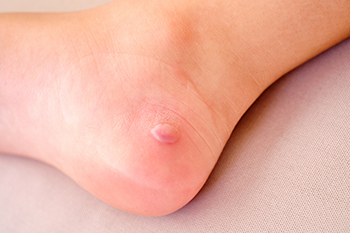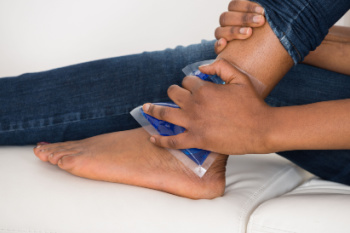
Foot blisters are small pockets of fluid that form when skin is irritated by friction, heat, or moisture. They often appear after long walks, wearing new shoes, or sweaty conditions. Common spots include the heels, toes, and soles. Although they may seem minor, blisters can become painful and even lead to infection if not treated properly. It is best not to pop them unless they are large or painful. Instead, keep the area clean, dry, and covered with a bandage or blister pad. Wearing moisture-wicking socks, well-fitting shoes, and using foot powder can help prevent future blisters. For people with diabetes or circulation issues, even small blisters should be taken seriously. If a blister becomes red, swollen, or does not heal, it is suggested you see a podiatrist for advanced treatment.
Blisters may appear as a single bubble or in a cluster. They can cause a lot of pain and may be filled with pus, blood, or watery serum. If your feet are hurting, contact one of our podiatrists of North Bay Ankle & Foot Center. Our doctors can provide the care you need to keep you pain-free and on your feet.
Foot Blisters
Foot blisters are often the result of friction. This happens due to the constant rubbing from shoes, which can lead to pain.
What Are Foot Blisters?
A foot blister is a small fluid-filled pocket that forms on the upper-most layer of the skin. Blisters are filled with clear fluid and can lead to blood drainage or pus if the area becomes infected.
Symptoms
(Blister symptoms may vary depending on what is causing them)
- Bubble of skin filled with fluid
- Redness
- Moderate to severe pain
- Itching
Prevention & Treatment
In order to prevent blisters, you should be sure to wear comfortable shoes with socks that cushion your feet and absorb sweat. Breaking a blister open may increase your chances of developing an infection. However, if your blister breaks, you should wash the area with soap and water immediately and then apply a bandage to the affected area. If your blisters cause severe pain it is important that you call your podiatrist right away.
If you have any questions, please feel free to contact our offices located in Petaluma and Sonoma, CA . We offer the newest diagnostic and treatment technologies for all your foot care needs.

Although gout is more common in adults, children and teenagers can develop it, especially if they have certain medical conditions or a family history. Gout is a form of arthritis caused by high levels of uric acid in the blood, which can form painful crystals in the joints. It often affects the big toe, and can produce excruciating pain. In younger individuals, it may be linked to kidney problems, obesity, or inherited disorders. Symptoms include joint pain, redness, and swelling, often in the big toe. Avoiding gout in children and teens involves maintaining a healthy weight, staying hydrated, and eating a balanced diet that limits high-purine foods such as red meat and sugary drinks. If your child has pain in the big toe, it is suggested that you promptly contact a podiatrist who can accurately diagnose gout, and offer relief and treatment solutions for this painful condition.
Gout is a foot condition that requires certain treatment and care. If you are seeking treatment, contact one of our podiatrists from North Bay Ankle & Foot Center. Our doctors will treat your foot and ankle needs.
What Is Gout?
Gout is a type of arthritis caused by a buildup of uric acid in the bloodstream. It often develops in the foot, especially the big toe area, although it can manifest in other parts of the body as well. Gout can make walking and standing very painful and is especially common in diabetics and the obese.
People typically get gout because of a poor diet. Genetic predisposition is also a factor. The children of parents who have had gout frequently have a chance of developing it themselves.
Gout can easily be identified by redness and inflammation of the big toe and the surrounding areas of the foot. Other symptoms include extreme fatigue, joint pain, and running high fevers. Sometimes corticosteroid drugs can be prescribed to treat gout, but the best way to combat this disease is to get more exercise and eat a better diet.
If you have any questions please feel free to contact our offices located in Petaluma and Sonoma, CA . We offer the newest diagnostic and treatment technologies for all your foot and ankle needs.

Hammertoe and mallet toe are common toe deformities, but they affect different joints. Hammertoe typically involves the second toe and bends at the middle joint, causing it to curl downward. Mallet toe, on the other hand, affects the joint closest to the toenail, making the tip of the toe point down. Both conditions often develop from pressure caused by wearing tight shoes, injury, or muscle imbalances. Early treatment may include switching to shoes with a roomy toe box, using protective padding, and performing toe-stretching exercises. In some cases, splints or orthotic inserts may help realign the toe. When these methods are not enough and pain or difficulty in walking persists, surgery may be necessary to correct the joint. If you notice your toe starting to bend unnaturally or becomes painful, it is suggested that you see a podiatrist for relief options.
Hammertoes can be a painful condition to live with. For more information, contact one of our podiatrists of North Bay Ankle & Foot Center. Our doctors will answer any of your foot- and ankle-related questions.
Hammertoe
Hammertoe is a foot deformity that occurs due to an imbalance in the muscles, tendons, or ligaments that normally hold the toe straight. It can be caused by the type of shoes you wear, your foot structure, trauma, and certain disease processes.
Symptoms
- Painful and/or difficult toe movement
- Swelling
- Joint stiffness
- Calluses/Corns
- Physical deformity
Risk Factors
- Age – The risk of hammertoe increases with age
- Sex – Women are more likely to have hammertoe compared to men
- Toe Length – You are more likely to develop hammertoe if your second toe is longer than your big toe
- Certain Diseases – Arthritis and diabetes may make you more likely to develop hammertoe
Treatment
If you have hammertoe, you should change into a more comfortable shoe that provides enough room for your toes. Exercises such as picking up marbles may strengthen and stretch your toe muscles. Nevertheless, it is important to seek assistance from a podiatrist in order to determine the severity of your hammertoe and see which treatment option will work best for you.
If you have any questions, please feel free to contact our offices located in Petaluma and Sonoma, CA . We offer the newest diagnostic and treatment technologies for all your foot care needs.

Ankle injuries, including sprains, strains, and fractures, are common and can range from mild to severe. Treatment depends on the type and extent of the injury. For minor sprains, rest, compression, and elevation can be effective. Supportive bracing and gentle stretching may follow once swelling decreases. More serious injuries may require immobilization in a boot or cast, especially if ligaments are torn or bones are fractured. Specific stretches can help to restore strength, balance, and range of motion. In rare cases, surgery may be needed to repair severe ligament damage or unstable fractures. Prompt attention and a clear treatment plan support better recovery and help prevent chronic instability or future injury. If you have ankle pain, swelling, or difficulty bearing weight after an injury, it is suggested you see a podiatrist for a diagnosis and appropriate treatment.
Ankle pain can have many different causes and the pain may potentially be serious. If you have ankle pain, consult with one of our podiatrists from North Bay Ankle & Foot Center. Our doctors will assess your condition and provide you with quality foot and ankle treatment.
Ankle pain is any condition that causes pain in the ankle. Due to the fact that the ankle consists of tendons, muscles, bones, and ligaments, ankle pain can come from a number of different conditions.
Causes
The most common causes of ankle pain include:
- Types of arthritis (rheumatoid, osteoarthritis, and gout)
- Ankle sprains
- Broken ankles
- Achilles tendinitis
- Achilles tendon rupture
- Stress fractures
- Tarsal tunnel syndrome
- Plantar fasciitis
Symptoms
Symptoms of ankle injury vary based upon the condition. Pain may include general pain and discomfort, swelling, aching, redness, bruising, burning or stabbing sensations, and/or loss of sensation.
Diagnosis
Due to the wide variety of potential causes of ankle pain, podiatrists will utilize a number of different methods to properly diagnose ankle pain. This can include asking for personal and family medical histories and of any recent injuries. Further diagnosis may include sensation tests, a physical examination, and potentially x-rays or other imaging tests.
Treatment
Just as the range of causes varies widely, so do treatments. Some more common treatments are rest, ice packs, keeping pressure off the foot, orthotics and braces, medication for inflammation and pain, and surgery.
If you have any questions, please feel free to contact our offices located in Petaluma and Sonoma, CA . We offer the newest diagnostic and treatment technologies for all your foot care needs.






